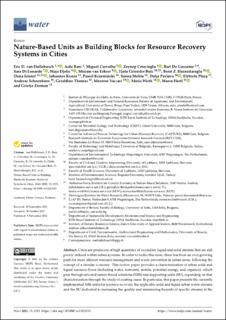Nature-Based Units as Building Blocks for Resource Recovery Systems in Cities
| dc.contributor.author | van Hullebusch, Eric D. | |
| dc.contributor.author | Bani, Aida | |
| dc.contributor.author | Carvalho, Miguel | |
| dc.contributor.author | Cetecioglu, Zeynep | |
| dc.contributor.author | De Gusseme, Bart | |
| dc.contributor.author | Di Lonardo, Sara | |
| dc.contributor.author | Djolic, Maja | |
| dc.contributor.author | van Eekert, Miriam | |
| dc.contributor.author | Bulc, Tjaša Griessler | |
| dc.contributor.author | Haznedaroglu, Berat Z. | |
| dc.contributor.author | Istenič, Darja | |
| dc.contributor.author | Kisser, Johannes | |
| dc.contributor.author | Krzeminski, Pawel | |
| dc.contributor.author | Melita, Sanna | |
| dc.contributor.author | Pavlova, Dolja | |
| dc.contributor.author | Płaza, Elżbieta | |
| dc.contributor.author | Schoenborn, Andreas | |
| dc.contributor.author | Thomas, Geraldine | |
| dc.contributor.author | Vaccari, Mentore | |
| dc.contributor.author | Wirth, Maria | |
| dc.contributor.author | Hartl, Marco | |
| dc.contributor.author | Zeeman, Grietje | |
| dc.date.accessioned | 2021-12-10T11:56:42Z | |
| dc.date.available | 2021-12-10T11:56:42Z | |
| dc.date.created | 2021-12-02T10:57:03Z | |
| dc.date.issued | 2021 | |
| dc.identifier.citation | Water. 2021, 13 (22), 3153. | en_US |
| dc.identifier.issn | 2073-4441 | |
| dc.identifier.uri | https://hdl.handle.net/11250/2833773 | |
| dc.description.abstract | Cities are producers of high quantities of secondary liquid and solid streams that are still poorly utilized within urban systems. In order to tackle this issue, there has been an ever-growing push for more efficient resource management and waste prevention in urban areas, following the concept of a circular economy. This review paper provides a characterization of urban solid and liquid resource flows (including water, nutrients, metals, potential energy, and organics), which pass through selected nature-based solutions (NBS) and supporting units (SU), expanding on that characterization through the study of existing cases. In particular, this paper presents the currently implemented NBS units for resource recovery, the applicable solid and liquid urban waste streams and the SU dedicated to increasing the quality and minimizing hazards of specific streams at the source level (e.g., concentrated fertilizers, disinfected recovered products). The recovery efficiency of systems, where NBS and SU are combined, operated at a micro- or meso-scale and applied at technology readiness levels higher than 5, is reviewed. The importance of collection and transport infrastructure, treatment and recovery technology, and (urban) agricultural or urban green reuse on the quantity and quality of input and output materials are discussed, also regarding the current main circularity and application challenges. | en_US |
| dc.language.iso | eng | en_US |
| dc.publisher | MDPI | en_US |
| dc.rights | Navngivelse 4.0 Internasjonal | * |
| dc.rights.uri | http://creativecommons.org/licenses/by/4.0/deed.no | * |
| dc.title | Nature-Based Units as Building Blocks for Resource Recovery Systems in Cities | en_US |
| dc.type | Peer reviewed | en_US |
| dc.type | Journal article | en_US |
| dc.description.version | publishedVersion | en_US |
| dc.rights.holder | © 2021 by the authors. | en_US |
| dc.source.pagenumber | 52 | en_US |
| dc.source.volume | 13 | en_US |
| dc.source.journal | Water | en_US |
| dc.source.issue | 22 | en_US |
| dc.identifier.doi | 10.3390/w13223153 | |
| dc.identifier.cristin | 1963227 | |
| dc.relation.project | Norges forskningsråd: 160016 | en_US |
| dc.source.articlenumber | 3153 | en_US |
| cristin.ispublished | true | |
| cristin.fulltext | original | |
| cristin.qualitycode | 1 |
Files in this item
This item appears in the following Collection(s)
-
Publikasjoner fra Cristin - NIVA [2160]
-
Scientific publications [1172]

